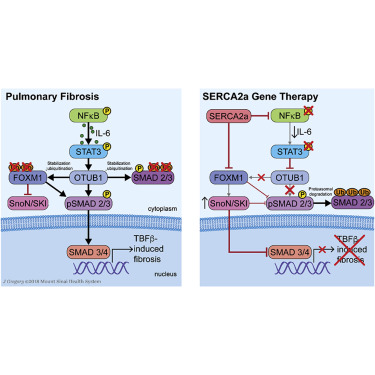当前位置:
X-MOL 学术
›
Mol. Ther.
›
论文详情
Our official English website, www.x-mol.net, welcomes your
feedback! (Note: you will need to create a separate account there.)
AAV1.SERCA2a Gene Therapy Reverses Pulmonary Fibrosis by Blocking the STAT3/FOXM1 Pathway and Promoting the SNON/SKI Axis.
Molecular Therapy ( IF 12.1 ) Pub Date : 2019-12-06 , DOI: 10.1016/j.ymthe.2019.11.027 Malik Bisserier 1 , Javier Milara 2 , Yassine Abdeldjebbar 1 , Sarah Gubara 1 , Carly Jones 1 , Carlos Bueno-Beti 1 , Elena Chepurko 1 , Erik Kohlbrenner 1 , Michael G Katz 1 , Sima Tarzami 3 , Julio Cortijo 2 , Jane Leopold 4 , Roger J Hajjar 5 , Yassine Sassi 1 , Lahouaria Hadri 1
Molecular Therapy ( IF 12.1 ) Pub Date : 2019-12-06 , DOI: 10.1016/j.ymthe.2019.11.027 Malik Bisserier 1 , Javier Milara 2 , Yassine Abdeldjebbar 1 , Sarah Gubara 1 , Carly Jones 1 , Carlos Bueno-Beti 1 , Elena Chepurko 1 , Erik Kohlbrenner 1 , Michael G Katz 1 , Sima Tarzami 3 , Julio Cortijo 2 , Jane Leopold 4 , Roger J Hajjar 5 , Yassine Sassi 1 , Lahouaria Hadri 1
Affiliation

|
Inhibition of pulmonary fibrosis (PF) by restoring sarco/endoplasmic reticulum calcium ATPase 2a isoform (SERCA2a) expression using targeted gene therapy may be a potentially powerful new treatment approach for PF. Here, we found that SERCA2a expression was significantly decreased in lung samples from patients with PF and in the bleomycin (BLM) mouse model of PF. In the BLM-induced PF model, intratracheal aerosolized adeno-associated virus serotype 1 (AAV1) encoding for human SERCA2a (AAV1.hSERCA2a) reduces lung fibrosis and associated vascular remodeling. SERCA2a gene therapy also decreases right ventricular pressure and hypertrophy in both prevention and curative protocols. In vitro, we observed that SERCA2a overexpression inhibits fibroblast proliferation, migration, and fibroblast-to-myofibroblast transition induced by transforming growth factor β (TGF-β1). Thus, pro-fibrotic gene expression is prevented by blocking nuclear factor κB (NF-κB)/interleukin-6 (IL-6)-induced signal transducer and activator of transcription 3 (STAT3) activation. This effect is signaled toward an inhibitory mechanism of small mother against decapentaplegic (SMAD)/TGF-β signaling through the repression of OTU deubiquitinase, ubiquitin aldehyde binding 1 (OTUB1) and Forkhead box M1 (FOXM1). Interestingly, this cross-inhibition leads to an increase of SKI and SnoN expression, an auto-inhibitory feedback loop of TGF-β signaling. Collectively, our results demonstrate that SERCA2a gene transfer attenuates bleomycin (BLM)-induced PF by blocking the STAT3/FOXM1 pathway and promoting the SNON/SKI Axis. Thus, SERCA2a gene therapy may be a potential therapeutic target for PF.
中文翻译:

AAV1.SERCA2a基因疗法可通过阻断STAT3 / FOXM1通路并促进SNON / SKI轴来逆转肺纤维化。
通过使用靶向基因疗法恢复肌/内质网钙ATPase 2a亚型(SERCA2a)表达来抑制肺纤维化(PF)可能是一种潜在的强有力的PF新治疗方法。在这里,我们发现在PF患者的肺部样本和PF的博来霉素(BLM)小鼠模型中,SERCA2a表达显着降低。在BLM诱导的PF模型中,对人SERCA2a(AAV1.hSERCA2a)编码的气管内气雾化腺相关病毒血清型1(AAV1)减少了肺纤维化和相关的血管重塑。SERCA2a基因治疗还可以在预防和治疗方案中降低右心室压力和肥大。在体外,我们观察到SERCA2a过表达抑制成纤维细胞增殖,迁移,转化生长因子β(TGF-β1)诱导的成纤维细胞向成肌纤维细胞过渡。因此,通过阻断核因子κB(NF-κB)/白介素6(IL-6)诱导的信号转导子和转录激活子3(STAT3)的激活来防止纤维化前基因的表达。通过抑制OTU去泛素酶,泛素醛结合1(OTUB1)和Forkhead box M1(FOXM1),可以指示小母亲抑制去甲肾上腺素能(SMAD)/TGF-β信号转导的机制。有趣的是,这种交叉抑制导致SKI和SnoN表达增加,这是TGF-β信号转导的自抑制反馈回路。总体而言,我们的结果表明,SERCA2a基因转移可通过阻断STAT3 / FOXM1途径并促进SNON / SKI轴来减弱博来霉素(BLM)诱导的PF。因此,
更新日期:2019-12-06
中文翻译:

AAV1.SERCA2a基因疗法可通过阻断STAT3 / FOXM1通路并促进SNON / SKI轴来逆转肺纤维化。
通过使用靶向基因疗法恢复肌/内质网钙ATPase 2a亚型(SERCA2a)表达来抑制肺纤维化(PF)可能是一种潜在的强有力的PF新治疗方法。在这里,我们发现在PF患者的肺部样本和PF的博来霉素(BLM)小鼠模型中,SERCA2a表达显着降低。在BLM诱导的PF模型中,对人SERCA2a(AAV1.hSERCA2a)编码的气管内气雾化腺相关病毒血清型1(AAV1)减少了肺纤维化和相关的血管重塑。SERCA2a基因治疗还可以在预防和治疗方案中降低右心室压力和肥大。在体外,我们观察到SERCA2a过表达抑制成纤维细胞增殖,迁移,转化生长因子β(TGF-β1)诱导的成纤维细胞向成肌纤维细胞过渡。因此,通过阻断核因子κB(NF-κB)/白介素6(IL-6)诱导的信号转导子和转录激活子3(STAT3)的激活来防止纤维化前基因的表达。通过抑制OTU去泛素酶,泛素醛结合1(OTUB1)和Forkhead box M1(FOXM1),可以指示小母亲抑制去甲肾上腺素能(SMAD)/TGF-β信号转导的机制。有趣的是,这种交叉抑制导致SKI和SnoN表达增加,这是TGF-β信号转导的自抑制反馈回路。总体而言,我们的结果表明,SERCA2a基因转移可通过阻断STAT3 / FOXM1途径并促进SNON / SKI轴来减弱博来霉素(BLM)诱导的PF。因此,











































 京公网安备 11010802027423号
京公网安备 11010802027423号